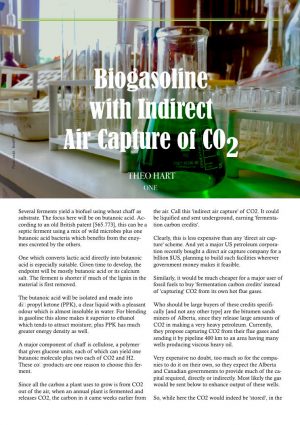 Several ferments yield a biofuel using wheat chaff as substrate. The focus here will be on butanoic acid. According to an old British patent [565.773], this can be a septic ferment using a mix of wild microbes plus one butanoic acid bacteria which benefits from the enzymes excreted by the others.
Several ferments yield a biofuel using wheat chaff as substrate. The focus here will be on butanoic acid. According to an old British patent [565.773], this can be a septic ferment using a mix of wild microbes plus one butanoic acid bacteria which benefits from the enzymes excreted by the others.
One which converts lactic acid directly into butanoic acid is especially suitable. Given time to develop, the endpoint will be mostly butanoic acid or its calcium salt. The ferment is shorter if much of the lignin in the material is first removed.
The butanoic acid will be isolated and made into di·propyl ketone (PPK), a clear liquid with a pleasant odour which is almost insoluble in water. For blending in gasoline this alone makes it superior to ethanol which tends to attract moisture; plus PPK has much greater energy density as well.
A major component of chaff is cellulose, a polymer that gives glucose units, each of which can yield one butanoic molecule plus two each of CO2 and H2. These co·products are one reason to choose this ferment.
Since all the carbon a plant uses to grow is from CO2 out of the air, when an annual plant is fermented and releases CO2, the carbon in it came weeks earlier from the air. Call this ‘indirect air capture’ of CO2. It could be liquified and sent underground, earning ‘fermentation carbon credits’.
Clearly, this is less expensive than any ‘direct air capture’ scheme. And yet a major US petroleum corporation recently bought a direct air capture company for a billion $US, planning to build such facilities wherever government money makes it feasible.
Similarly, it would be much cheaper for a major user of fossil fuels to buy ‘fermentation carbon credits’ instead of ‘capturing’ CO2 from its own hot flue gases.
Who should be large buyers of these credits specifically [and not any other type] are the bitumen sands miners of Alberta, since they release large amounts of CO2 in making a very heavy petroleum. Currently, they propose capturing CO2 from their flue gases and sending it by pipeline 400 km to an area having many wells producing viscous heavy oil.
Very expensive no doubt, too much so for the companies to do it on their own, so they expect the Alberta and Canadian governments to provide much of the capital required, directly or indirectly. Most likely the gas would be sent below to enhance output of these wells.
So, while here the CO2 would indeed be ‘stored’, in the sense that it goes below and stays below, it would also be increasing production of a fossil fuel. Any government support will be criticized as furthering fossil fuel production.
A recent demonstration project in North Dakota, partly funded by the US Department of Energy, liquifies the CO2 from an ethanol producer to send underground. This is indirect air capture of CO2. In the USA are several hundred such ethanol plants, nearly all using starchy grains as substrate.
But their finances are precarious at times, as these grains are much wanted both there and abroad for feeding poultry and swine. Income from selling the ‘fermentation carbon credits’ would improve their situation.
Saskatchewan
Wheat chaff is an inexpensive starting material for a ferment, and Saskatchewan is a very large wheat producer. Of its more than 14.5 million hectares of grains and oilseeds harvested in a typical year, spring wheat would be 3 million, durum nearly 2, barley about 1, with canola about 5 million hectares.
The frost-free period runs 115 to 120 days usually, which precludes growing maize or sunflowers for their seeds — too much risk of frost damaging these crops reducing their value. To shorten the harvest, the cereals are cut and windrows created so the crops can dry sooner.
Chaff comes from threshing wheat to obtain the grain. Current practice is to thresh in the field using a combine harvester. It is a big expensive beast of a machine divided in two. The main body is a mobile thresher which retains the grain and strews chaff and straw on the ground. A small front unit picks up the dried windrows to feed the thresher.
Periodically, grain is off-loaded into a truck or wagon. Now, if cereal chaff has value and is to be taken from the field, the harvest should change. When both grain & chaff are wanted, take the entire grain heads intact — cut when mature but far from dry — and air dry them before threshing. Barley and wheat are bearded with long awns, so much air space exists within a pile letting humid air to drain out and wind to blow in, hastening the process.
Park the combine, as only a header is needed attached to a swather style ‘tractor’, with a belt conveyor or thrower sending heads into a wagon — simpler equipment, smaller engine, cheaper to acquire and less expense to run. Quicker and earlier field work as well.
Being bearded, the heads interlock when lightly compacted and hold that shape. So a stack former or pendulum-type soft round baler could be used, or a ‘tall’ firm windrow made. The heads may then be left in the field several days before being gathered.
Thresh the heads weeks later when they are very dry and press the chaff into pellets. Adding a minor amount of lye, soda, or sodium acetate prior to compaction helps the fermentor. Both thresher and pelleter could be run by hydraulic motors, the fluid coming from a storage tank kept up in pressure by an hydraulic pump directly attached to a windmill. Wind is nearly always present on the farmlands of Saskatchewan.
Processing
Delivered to the processor are chaff pellets which contain a small amount of chemical that has reacted with the xylan to an extent, due to the heat generated in pellet formation. Also, the acetyls on the xylan will now be sodium acetate or acetic acid.
This is the fermentation substrate for the mix of wild microbes plus one producing mainly butanoic acid. At the end of the ferment, some acetic acid will also likely be there. Being in dilute amounts, concentration and isolation are required to obtain them. This step might be the most diverse among processors, as several means of doing it may be used. Freeze concentration is one.
Some processors might choose to absorb the remaining liquid on wastepaper or straw and grow fungi on it in order to obtain an organic fertiliser having quite a bit of nitrogen.
In future, engineered thermophilic bacteria which convert acetic acid into acetone will exist, its vapour escaping. Then the primary ferment of chaff may be to acetic acid rather than the butanoic.
Acetone plus H2 in a one-step process gives methyl-isobutyl ketone [MiBK] to blend with gasoline. Many petroleum refineries do that now. But it is only one biogasoline possibility, and as dozens of processors would come to exist, they won’t all be using the same technology.
As instance, in making MiBK, the H2 is only there to saturate a created double bond, for which instead an alcohol will do. Or instead of acetone as the ketone, butanone works, it being arrived at readily from a 2-3, butanediol ferment [which also produces much CO2]. There are, of course, other possibilities.
Theo Hart





